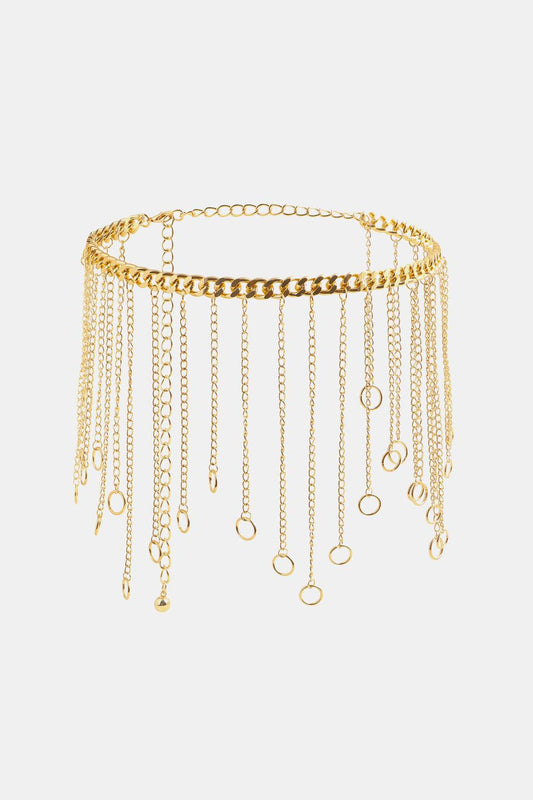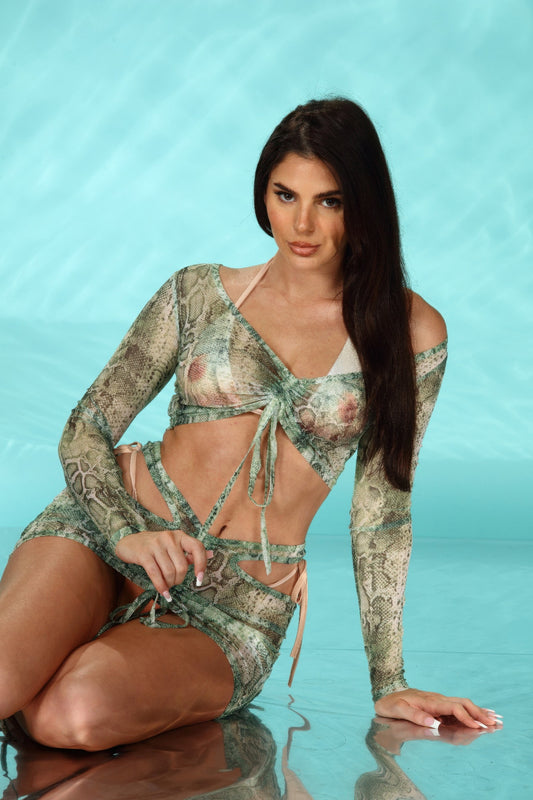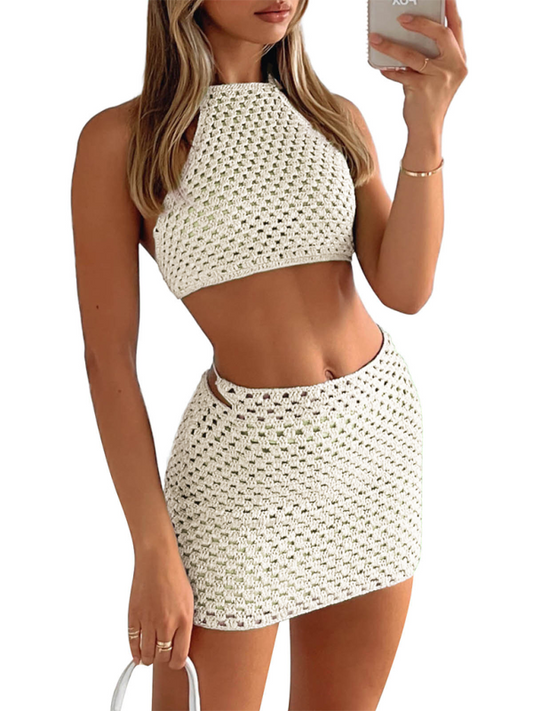Festival Outfits
-
Fringe Chain Alloy Belt
Regular price £18.00 GBPRegular priceUnit price / per£25.00 GBPSale price £18.00 GBPSale -
Printed Sheer Two Piece Set
Regular price £28.00 GBPRegular priceUnit price / per£56.00 GBPSale price £28.00 GBPSale -
Blue Zone Planet | Oriana's Halter Neck Backless Crop Top & Bodycon Mini Skirt Suit
Regular price £37.00 GBPRegular priceUnit price / per£55.00 GBPSale price £37.00 GBPSale -
Katy's Vinyl & Fishnet Panel Romper
Regular price £76.00 GBPRegular priceUnit price / per£95.00 GBPSale price £76.00 GBPSale -
Plus Size Sheer Mesh Skirt
Regular price £45.00 GBPRegular priceUnit price / per£57.00 GBPSale price £45.00 GBPSale -
Vixen's Vinyl High-Waisted Shorts With Attached Leg Straps & Bow Detail
Regular price £38.00 GBPRegular priceUnit price / per£55.00 GBPSale price £38.00 GBPSale -
Vixen's Vinyl Bikini Tie Top With Bow Detail
Regular price £38.00 GBPRegular priceUnit price / per£55.00 GBPSale price £38.00 GBPSale -
Large Keyhole Metallic Romper
Regular price £76.00 GBPRegular priceUnit price / per£95.00 GBPSale price £76.00 GBPSale -
Shimmer Multi-Colored Criss Cross Bottoms
Regular price £45.00 GBPRegular priceUnit price / per£57.00 GBPSale price £45.00 GBPSale -
![6472 - Mesh & Vinyl Romper-TOPS / DRESSES-[Adult]-[Female]-Small-Black-2022 Online Blue Zone Planet](//bluezoneplanet.com/cdn/shop/files/6472.jpg?v=1711232458&width=533) Sale
SaleMesh & Vinyl Romper
Regular price £86.00 GBPRegular priceUnit price / per£107.00 GBPSale price £86.00 GBPSale -
Shimmer Multi-Colored High Waisted Shorts
Regular price £47.00 GBPRegular priceUnit price / per£59.00 GBPSale price £47.00 GBPSale -
Shimmer Multi-Colored Keyhole High Waisted Shorts
Regular price £52.00 GBPRegular priceUnit price / per£64.00 GBPSale price £52.00 GBPSale -
Shimmer Multi-Colored Bikini Top
Regular price £31.00 GBPRegular priceUnit price / per£39.00 GBPSale price £31.00 GBPSale -
Shimmer Multi-Colored Romper
Regular price £78.00 GBPRegular priceUnit price / per£97.00 GBPSale price £78.00 GBPSale -
Shimmer Multi-Colored Bikini Top
Regular price £52.00 GBPRegular priceUnit price / per£64.00 GBPSale price £52.00 GBPSale -
Sheer Mesh Floor Length Shrug
Regular price £47.00 GBPRegular priceUnit price / per£59.00 GBPSale price £47.00 GBPSale -
Metallic Iridescent High-Waisted Shorts
Regular price £55.00 GBPRegular priceUnit price / per£68.00 GBPSale price £55.00 GBPSale -
Metallic Iridescent Bikini Top
Regular price £47.00 GBPRegular priceUnit price / per£59.00 GBPSale price £47.00 GBPSale -
Metallic Iridescent Criss Cross Bikini Top
Regular price £62.00 GBPRegular priceUnit price / per£78.00 GBPSale price £62.00 GBPSale -
Blue Zone Planet | Clarissa's Metallic Iridescent Shrug With Ruffle Detail
Regular price £45.00 GBPRegular priceUnit price / per£57.00 GBPSale price £45.00 GBPSale -
Metallic Iridescent Shorts With Attached Leg Wrap
Regular price £30.00 GBPRegular priceUnit price / per£45.00 GBPSale price £30.00 GBPSale -
Metallic Iridescent Ruffled Top
Regular price £45.00 GBPRegular priceUnit price / per£57.00 GBPSale price £45.00 GBPSale -
Metallic Iridescent Keyhole Romper
Regular price £78.00 GBPRegular priceUnit price / per£97.00 GBPSale price £78.00 GBPSale -
Sequin Fishnet Bikini Top
Regular price £30.00 GBPRegular priceUnit price / per£37.00 GBPSale price £30.00 GBPSale
Collection: Festival Outfits
The New Age of Festival Fashion: Redefining Women's Wear
In the evolving landscape of festival fashion, a seismic shift is occurring, one that intertwines the threads of technology, sustainability, and cultural awareness. This metamorphosis in women's festival wear is not just a trend; it's a revolution. As we embrace a new age of festival-going, the attire of festival-goers, particularly women, has become a canvas for expression, innovation, and connection.
The Evolution of Festival Fashion
Historically, festival fashion has been synonymous with bohemian rhapsodies, a free-spirited mix of the '60s flower power and the '70s hippie movement. Think Woodstock, with its flowing skirts, flower crowns, and fringed vests. Fast forward to the 21st century, and while these elements remain, they have evolved into something more significant, reflective of the modern woman's ethos.
The Integration of Technology
In an era where technology touches every aspect of our lives, it's no surprise that it has woven its way into festival fashion. Smart fabrics and wearable technology have started to appear in festival attire. Dresses that change color based on the wearer's movements, interactive LED-lit accessories, and solar-powered backpacks are no longer figments of the imagination but tangible realities. These innovations are not just for show; they embody a sense of futurism and functionality, aligning with the modern festival-goer's desire for convenience and connectivity.
Sustainability: A Core Principle
Perhaps the most significant evolution in festival fashion is the shift towards sustainability. In response to the increasing awareness of the fashion industry's environmental impact, festival wear is turning green. Biodegradable glitters, upcycled materials, and ethically sourced fabrics are becoming the norm. This change reflects a deeper understanding and respect for the environment, mirroring the ethos of many festival themes that emphasize oneness with nature.
Cultural Sensitivity and Inclusivity
The new age of festival fashion is also marked by a growing awareness of cultural sensitivity and inclusivity. There's a fine line between cultural appropriation and appreciation, and today's designers are more mindful of this distinction. Incorporating designs that honor and respect different cultures without misappropriating them is a delicate balance that many are striving to achieve. Additionally, inclusivity in sizes, shapes, and expressions of gender identity is increasingly prevalent, making festival fashion a domain where every woman can see herself represented.
Technology Meets Tradition
An intriguing aspect of this evolution is the blend of cutting-edge technology with traditional craftsmanship. Artisans from various cultures are collaborating with tech-savvy designers to create unique pieces that tell a story. This fusion not only preserves traditional art forms but also introduces them to a new, global audience.
The Future of Festival Fashion
As we look to the future, the convergence of technology, sustainability, and cultural awareness in women's festival wear is set to deepen. With advances in eco-friendly materials and wearable tech, combined with a growing consciousness about the world we live in and the cultures we celebrate, festival fashion is on the cusp of something truly transformative.
Conclusion
The new age of women's festival wear is more than just clothing; it's a movement. It's an intersection of art, technology, ethics, and culture. As we dance under open skies, our fashion choices reflect our values, our innovations, and our respect for the tapestry of cultures that surround us.
Key Points to Understand the Subject
Technology Integration: Modern festival fashion incorporates wearable technology, blending style with functionality and futurism.
Sustainability Focus: There's a significant shift towards eco-friendly and sustainable practices in festival wear, reflecting a broader environmental consciousness.
Cultural Sensitivity and Inclusivity: Today's festival fashion is more culturally sensitive and inclusive, respecting diverse traditions while ensuring that fashion is accessible to all women, regardless of size or shape.
Q1: How has technology influenced women's festival fashion?
A: Technology has had a profound impact on festival fashion, particularly for women. It's manifested in smart fabrics that react to stimuli, interactive accessories with LED lights, and even solar-powered clothing items. These advancements offer not only a futuristic aesthetic but also practical benefits, like connectivity and convenience.
Q2: Why is sustainability important in festival fashion?
A: Sustainability is crucial due to the growing awareness of the fashion industry's environmental impact. In festival fashion, this translates to the use of biodegradable materials, upcycled clothing, and ethically sourced fabrics. It reflects a shift in consumer values towards more environmentally responsible choices.
Q3: What is the significance of cultural sensitivity in festival wear?
A: Cultural sensitivity is essential to avoid cultural appropriation, a concern in the past with festival attire. Modern festival wear is more about appreciating and respecting different cultures rather than misappropriating them. This approach fosters inclusivity and ensures that fashion celebrates diversity without overstepping cultural boundaries.
Q4: Can festival fashion be both stylish and comfortable?
A: Absolutely! Modern festival fashion strikes a balance between aesthetics and comfort. Designers are focusing on creating pieces that are not only visually appealing but also comfortable to wear, recognizing that festival-goers need to move freely and feel at ease during long hours of festivities.
Q5: How do traditional crafts fit into the modern festival fashion scene?
A: Traditional crafts are increasingly being incorporated into modern festival fashion through collaborations between artisans and contemporary designers. This fusion celebrates and preserves traditional techniques while presenting them in a modern context, appealing to a global audience and adding depth and authenticity to the festival experience.
Q6: Are there options for all body types in festival fashion?
A: Yes, inclusivity in sizes and shapes is a growing trend in festival fashion. Designers and brands are expanding their offerings to cater to a diverse range of body types, ensuring that everyone can find something that makes them feel confident and comfortable.
Q7: How can festival-goers make more sustainable fashion choices?
A: Festival-goers can opt for clothing made from sustainable materials, support brands that use ethical manufacturing practices, and consider upcycling or repurposing existing garments. Also, choosing timeless pieces over fast fashion ensures longer wear and less environmental impact.
Q8: Is wearable technology in festival fashion accessible to everyone?
A: While wearable technology in fashion is becoming more common, its accessibility varies. Some high-tech pieces might be expensive, but there are also more affordable options. The market is expanding, making these innovative pieces more accessible over time.
Q9: How does festival fashion reflect the ethos of modern festivals?
A: Modern festival fashion mirrors the ethos of the festivals themselves, which often emphasize sustainability, cultural diversity, community, and self-expression. The clothing worn at these events is a way for attendees to connect with these values and express their personal identity.
Q10: Can festival fashion impact broader fashion trends?
A: Yes, festival fashion often influences broader fashion trends. The creativity, innovation, and freedom of expression seen in festival wear can inspire mainstream fashion, introducing new styles, patterns, and ideas to a wider audience.




![6477 - Vinyl & Fishnet Panel Romper-TOPS / DRESSES-[Adult]-[Female]-Small-Baby Pink-2022 Online Blue Zone Planet](http://bluezoneplanet.com/cdn/shop/files/6477_BP.jpg?v=1711232420&width=533)
![6542 - Sheer Mesh Skirt-TOPS / DRESSES-[Adult]-[Female]-X-Large-Black-2022 Online Blue Zone Planet](http://bluezoneplanet.com/cdn/shop/files/6479Q_6483Q_6542Q_Blk_563edefc-d569-49b6-8239-ccb504daefe6.jpg?v=1711232226&width=533)
![6476 - Vinyl High-Waisted Shorts-TOPS / DRESSES-[Adult]-[Female]-Small-Black-2022 Online Blue Zone Planet](http://bluezoneplanet.com/cdn/shop/files/6475_6476_ff1291b3-1736-492b-b74f-3aa6a6c26e65.jpg?v=1711232429&width=533)
![6475 - Vinyl Bikini Tie Top-TOPS / DRESSES-[Adult]-[Female]-Small-Black-2022 Online Blue Zone Planet](http://bluezoneplanet.com/cdn/shop/files/6475_6476.jpg?v=1711232439&width=533)
![6471 - Large Keyhole Metallic Romper-TOPS / DRESSES-[Adult]-[Female]-Small-Green-2022 Online Blue Zone Planet](http://bluezoneplanet.com/cdn/shop/files/6471_Green.jpg?v=1711232467&width=533)
![6469 - Shimmer Multi-Colored Criss Cross Bottoms-TOPS / DRESSES-[Adult]-[Female]-Small-Multi-2022 Online Blue Zone Planet](http://bluezoneplanet.com/cdn/shop/files/6468_6469_f84d8e13-0f5b-4fa6-b34e-fd8a2705e255.jpg?v=1711232479&width=533)
![6472 - Mesh & Vinyl Romper-TOPS / DRESSES-[Adult]-[Female]-Small-Black-2022 Online Blue Zone Planet](http://bluezoneplanet.com/cdn/shop/files/6472.jpg?v=1711232458&width=533)
![6465 - Shimmer Multi-Colored High Waisted Shorts-TOPS / DRESSES-[Adult]-[Female]-Small-Multi-2022 Online Blue Zone Planet](http://bluezoneplanet.com/cdn/shop/files/6464_6465_d574f4f5-22b3-40c4-9806-a81e72aa5b53.jpg?v=1711232501&width=533)
![6467 - Shimmer Multi-Colored Keyhole High Waisted Shorts-TOPS / DRESSES-[Adult]-[Female]-Small-Multi-2022 Online Blue Zone Planet](http://bluezoneplanet.com/cdn/shop/files/6466_6467_66e0ae64-fad7-4a92-8b28-66d58b4e37e9.jpg?v=1711232489&width=533)
![6468 - Shimmer Multi-Colored Bikini Top-TOPS / DRESSES-[Adult]-[Female]-One Size-Multi-2022 Online Blue Zone Planet](http://bluezoneplanet.com/cdn/shop/files/6468_6469.jpg?v=1711232485&width=533)
![6462- Shimmer Multi-Colored Romper-TOPS / DRESSES-[Adult]-[Female]-Small-Multi/Baby Pink-2022 Online Blue Zone Planet](http://bluezoneplanet.com/cdn/shop/files/6462.jpg?v=1711232518&width=533)
![6464 - Shimmer Multi-Colored Bikini Top-TOPS / DRESSES-[Adult]-[Female]-Small-Multi-2022 Online Blue Zone Planet](http://bluezoneplanet.com/cdn/shop/files/6464_6465.jpg?v=1711232507&width=533)
![6463 - Sheer Mesh Floor Length Shrug-TOPS / DRESSES-[Adult]-[Female]-One Size-Baby Pink-2022 Online Blue Zone Planet](http://bluezoneplanet.com/cdn/shop/files/6462_6463_fd959557-4c4a-456f-acf0-78b58b7c5c2e.jpg?v=1711232512&width=533)
![6457 - Metallic Iridescent High-Waisted Shorts-TOPS / DRESSES-[Adult]-[Female]-Small-Baby Pink-2022 Online Blue Zone Planet](http://bluezoneplanet.com/cdn/shop/files/6456_6457_BP_cf7e9b51-9dec-4667-91c6-c86b50e49eea.jpg?v=1711232545&width=533)
![6456 - Metallic Iridescent Bikini Top-TOPS / DRESSES-[Adult]-[Female]-Small-Baby Pink-2022 Online Blue Zone Planet](http://bluezoneplanet.com/cdn/shop/files/6456_6457_BP.jpg?v=1711232551&width=533)
![6454 - Metallic Iridescent Criss Cross Bikini Top-TOPS / DRESSES-[Adult]-[Female]-Small-White-2022 Online Blue Zone Planet](http://bluezoneplanet.com/cdn/shop/files/6454_6455_Wht.jpg?v=1711232581&width=533)
![6451 - Metallic Iridescent Shrug with Ruffle Detail-TOPS / DRESSES-[Adult]-[Female]-Small-White-2022 Online Blue Zone Planet](http://bluezoneplanet.com/cdn/shop/files/6450_6451_6452_Wht_3747092a-c850-4c0c-a5ad-b499c363f307.jpg?v=1711232614&width=533)
![6444 - Metallic Iridescent Shorts-TOPS / DRESSES-[Adult]-[Female]-Small-Baby Pink-2022 Online Blue Zone Planet](http://bluezoneplanet.com/cdn/shop/files/6443_6444_BP_304bb469-8ead-4b25-bcf8-eafd93f7e998.jpg?v=1711232683&width=533)
![6447 - Metallic Iridescent Ruffled Top-TOPS / DRESSES-[Adult]-[Female]-Small-White-2022 Online Blue Zone Planet](http://bluezoneplanet.com/cdn/shop/files/6447_6446_Wht_2f10b23e-7290-4ce7-a9e0-8f0dd250198c.jpg?v=1711232655&width=533)
![6441 - Metallic Iridescent Keyhole Romper-TOPS / DRESSES-[Adult]-[Female]-Small-White-2022 Online Blue Zone Planet](http://bluezoneplanet.com/cdn/shop/files/6441_Wht.jpg?v=1711232706&width=533)
![6435 - Sequin Fishnet Bikini Top-TOPS / DRESSES-[Adult]-[Female]-Small-Black-2022 Online Blue Zone Planet](http://bluezoneplanet.com/cdn/shop/files/6435_6436_Blk.jpg?v=1711232760&width=533)